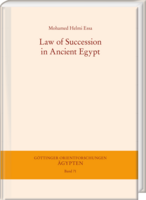|
In Law of Succession in Ancient Egypt Mohamed Helmi Essa Ahmed explores one of the oldest inheritance laws in the world, which is probably the oldest known to mankind. He draws on 58 carefully selected texts from Ancient Egypt, spanning from the dawn of civilization to the end of the Late Period and thus provides an in-depth look at Egyptian terminology related to property, focusing specifically on inheritance and the types of property passed from a testator to their heir, including movable assets like furniture and clothing, as well as immovable properties such as land and buildings. The author investigates the complex aspects of succession, highlighting the roles of family members in the inheritance process and analyzes the development of succession law during pharaonic time, considering both intestate and testate succession and how inheritance was distributed within families throughout history.
Additionally the book covers litigation and disinheritance in three sections: The first section deals at the statutory bodies that handle inheritance disputes and related legal proceedings. The second section reviews notable examples of inheritance conflicts from history, while the third section explores reasons for disinheritance in Ancient Egypt. Despite extensive knowledge, little effort has been made to systematically categorize the above-mentioned items, which makes the comprehensive account of property types in this study particularly valuable and enhances our understanding of Ancient Egyptian inheritance practices and their social dynamics. |






